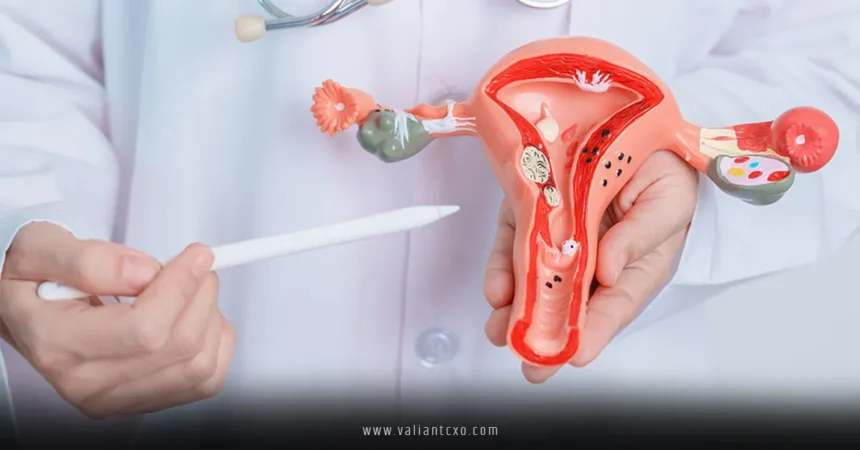Endometriosis sneaks up on so many women, turning what should be a normal part of life into a battlefield of pain and frustration. Imagine tissue that’s meant to line your uterus deciding to set up camp elsewhere in your body – that’s endometriosis in a nutshell. It’s a condition that affects millions, yet it often flies under the radar until symptoms become impossible to ignore. If you’re dealing with chronic pelvic pain or wondering why your periods feel like a monthly war zone, stick around. We’re diving deep into everything you need to know about endometriosis, from its sneaky symptoms to smart ways to manage it.
What Is Endometriosis?
Let’s start with the basics: what exactly is endometriosis? Picture this – your uterus has a lining called the endometrium that builds up and sheds each month during your period. In endometriosis, similar tissue grows outside the uterus, often on ovaries, fallopian tubes, or the pelvic lining. This rogue tissue acts just like the real deal: it thickens, breaks down, and bleeds with your cycle. But here’s the catch – it has nowhere to go, so it causes inflammation, scarring, and sometimes cysts known as endometriomas.
Why does this matter? Because endometriosis isn’t just a “bad period” issue. It’s a full-body puzzle that can mess with your hormones, immune system, and daily life. It hits about one in ten women worldwide, from teens to those in their 40s, and doesn’t discriminate based on race or background. Have you ever felt like your body is betraying you? That’s how many describe endometriosis – a silent invader that can lead to adhesions, where organs stick together like glue, causing even more chaos.
Endometriosis comes in stages, from 1 to 4, based on how much tissue is involved and where it’s spread. But get this: stage doesn’t always match pain levels. You could have stage 1 endometriosis with excruciating symptoms or stage 4 with barely a whisper of discomfort. It’s quirky like that, which is why understanding your own body is key.
Common Symptoms of Endometriosis
Oh boy, the symptoms of endometriosis can be a real rollercoaster. The star of the show? Pelvic pain that’s often worse than your average cramps. It might crank up during your period, but don’t be surprised if it lingers or pops up during sex, bowel movements, or even urination. Think of it like a faulty alarm system – it goes off when it shouldn’t, leaving you exhausted.
Other red flags include heavy bleeding, spotting between periods, fatigue that hits like a truck, and gut issues like bloating, diarrhea, or constipation, especially around your cycle. Nausea? Check. Infertility? Sadly, yes – up to half of women with endometriosis struggle to conceive because the tissue can block tubes or mess with egg quality. And here’s a kicker: some folks have no symptoms at all, only discovering endometriosis during fertility checks or unrelated surgeries.
Rhetorical question time: Ever wondered why your pain gets dismissed as “just cramps”? That’s because endometriosis symptoms mimic other issues like IBS or ovarian cysts, leading to misdiagnoses. If you’re nodding along, it’s time to chat with a doc – early awareness can change everything.
Causes and Risk Factors for Endometriosis
What sparks endometriosis? Scientists are still piecing it together, but theories abound. One popular idea is retrograde menstruation: menstrual blood flows backward through the fallopian tubes, planting endometrial cells in the pelvis where they grow wild. Another? Embryonic cells transforming under hormonal influence, or even surgical scars from C-sections acting as landing pads for these cells.
Genetics play a role too – if your mom or sister has endometriosis, your risk jumps. Other factors? Starting periods early, short cycles, heavy flows, or higher estrogen exposure over your lifetime. Low BMI or never having kids can up the odds, while pregnancy might offer temporary relief. It’s like a perfect storm of biology and environment.
Immune system glitches might let these cells thrive instead of zapping them. And in rare cases, endometriosis can wander to far-flung spots like the lungs or brain, turning it into a systemic headache. Understanding these causes helps demystify why endometriosis feels so personal and unpredictable.
Diagnosing Endometriosis: The Journey to Answers
Diagnosing endometriosis isn’t a walk in the park – it often takes years, averaging about a decade from first symptoms. Why? No simple blood test exists. It starts with your story: detailing pain, family history, and symptoms to a gynecologist. A pelvic exam might follow, feeling for abnormalities.
Imaging like ultrasounds or MRIs can spot cysts or deep tissue, but they’re not foolproof. The gold standard? Laparoscopy – a minimally invasive surgery where a camera peeks inside, and docs can biopsy suspicious spots for confirmation. Sometimes, they even treat during the same procedure by removing tissue.
Ever felt gaslighted by doctors saying “it’s all in your head”? That’s a common hurdle with endometriosis, often mistaken for mental health issues or other ailments. Persistence pays off – finding a specialist who listens can be a game-changer.
Treatment Options for Endometriosis
Good news: endometriosis treatments can ease the burden. Pain relief starts simple with NSAIDs like ibuprofen to tame cramps and inflammation. Hormonal therapies are next – birth control pills, patches, or IUDs suppress cycles, starving the tissue of estrogen fuel. GnRH agonists or antagonists like Lupron or Orilissa dial down hormones, mimicking menopause to shrink growths.
For tougher cases, surgery shines. Laparoscopic excision removes lesions root and stem, offering longer relief than just burning them away. Hysterectomy? It’s an option for severe endometriosis but not a cure-all, as tissue can linger outside the uterus.
Complementary approaches help too: acupuncture for pain, diet tweaks avoiding inflammatory foods, or physical therapy to loosen adhesions. Remember, treatments are personalized – what works for one might not for another. If fertility’s a goal, combining surgery with IVF could be your path.
Living with Endometriosis: Tips and Strategies
Living with endometriosis means building a toolkit for daily wins. Exercise gently – yoga or swimming can ease pain without aggravating it. Diet matters: load up on anti-inflammatory foods like berries, fish, and greens, while ditching caffeine or alcohol if they trigger flares.
Emotional support is crucial. Endometriosis can tank your mood, relationships, and work life, so therapy or support groups provide a lifeline. Track symptoms in a journal to spot patterns and share with your doc.
Sex might hurt, but communication with partners and lubricants or positions can help. And for work or school? Advocate for accommodations – endometriosis is chronic, but you don’t have to suffer silently. It’s like training for a marathon: pace yourself, celebrate small victories, and lean on your team.
Endometriosis and Fertility: Navigating the Challenges
Endometriosis and babies – a tricky combo. It can scar tubes, inflame the pelvis, or disrupt ovulation, making conception harder for about 30-50% of those affected. But hope abounds: many conceive naturally or with help like fertility meds or surgery to clear blockages.
Timing matters – chat with a reproductive specialist early. IVF bypasses some issues, and freezing eggs preserves options. Analogy alert: think of endometriosis as roadblocks on your fertility highway; treatments clear the path, boosting your chances.
Busting Myths About Endometriosis
Myths swirl around endometriosis like fog. Myth: Pain equals severity. Fact: No correlation – mild endometriosis can hurt like hell, while advanced cases might be silent.
Myth: Pregnancy cures it. Fact: It might pause symptoms, but endometriosis often returns post-baby.
Myth: It’s preventable. Fact: No known way, but awareness helps catch it early. Clearing these up empowers you to seek real help.
Latest Insights and Research on Endometriosis
Research on endometriosis is heating up. Scientists eye genetic links and immune therapies to target root causes. New drugs aim to block estrogen without side effects, and stem cell studies offer future hope.
Studies link endometriosis to higher risks of ovarian cancer, though rare, so regular check-ups are wise. Advocacy groups push for better diagnosis tools – imagine a non-invasive test someday!
Conclusion
Endometriosis is a tough nut, but armed with knowledge, you can crack it. We’ve covered the what, why, and how – from symptoms like debilitating pain to treatments blending meds, surgery, and lifestyle hacks. Remember, you’re not alone in this fight; millions battle endometriosis daily, and progress is happening. Take charge: listen to your body, find supportive care, and advocate for yourself. Whether you’re newly diagnosed or long in the game, managing endometriosis starts with one step – reaching out. You’ve got this; brighter days await.
FAQs About Endometriosis
What are the first signs of endometriosis?
Early signs of endometriosis often include intense pelvic pain during periods, pain during sex, or irregular bleeding. If these sound familiar, consult a doctor for evaluation.
Can endometriosis go away on its own?
Endometriosis rarely vanishes without intervention, but symptoms may ease after menopause. However, ongoing management is key for most people dealing with endometriosis.
How does endometriosis affect daily life?
Endometriosis can disrupt work, relationships, and energy levels due to chronic pain and fatigue. Lifestyle adjustments and support help many thrive despite it.
Is surgery the only cure for endometriosis?
Surgery like laparoscopic excision can remove endometriosis tissue effectively, but it’s not always a permanent cure. Combining it with hormones often works best.
Does diet impact endometriosis symptoms?
Yes, an anti-inflammatory diet rich in fruits, veggies, and omega-3s may reduce endometriosis flares, though it’s not a standalone fix – always pair with medical advice.
Read More :valiantcxo.com


